| Many of my gallery clients know that I frequently travel during weekdays, not necessarily on vacations, but on aggressive traveling journeys—enjoying taking in the magnificent sights, different people, rich histories, and diverse cultures I encounter on my trips while studying fine art and masterpieces, learning about different artists, and looking to add to my gallery knowledge. For example, in 2008, I traveled five times to Europe, including two trips to Vienna for museum shows at The Leopold, The Belvedere, and The Albertina, one trip to London’s Tate Britain Museum for a retrospective, and trips to Italy and France to view La Cappella Sistina in Rome and to visit The Louvre in Paris. In addition to my travels abroad, I regularly take in art collections in nearby cities, such as Philadelphia and New York, including a recent visit to The Barnes Foundation in Pennsylvania.
My career as an art dealer is no accident or random career selection; my interest in art is life-long, stemming from my time spent painting my own art, my design experience, and my constant quest to see, study, and learn as much as possible about art and life’s beauty. I live a life driven by the arts, realizing that every aspect of life lends itself to artistry and creativity. I include this background to put into perspective my enthusiasm for the recently viewed museum show of Russian artists.
Early in 2009, on January 30th and 31st, I had the opportunity to be part of a museum show when I attended the opening of the “Kugach, Kugach, Kugach:Three Generations of Russian Artists” exhibit at the American University Museum’s Katzen Arts Center in Washington, D.C. The Russian Realist oil paintings of the talented Kugach patriarch, Yuri; his son, Mikhail; his grandson, Ivan; his wife, Olga Svetlechnaya; his granddaughter, Ekaterina; and his nephew, Nikita Fedesov, inspired me and provided so much personal joy as I took in the weekend events leading up to the exhibit opening, featuring over 100 Kugach family paintings.
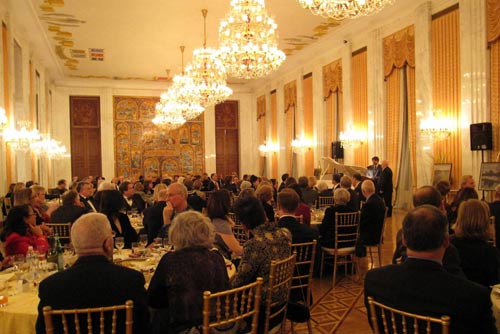
Russian Embassy Global Arts Network fundraising Gala
Beginning Friday, January 30th, a pre-event fundraiser took place with a dinner at the Russian Embassy, hosted by Luba Taubvurtzel, president and founder of the Global Arts Network. Speakers included American University Museum director and curator, Dr. Jack Rasmussen, and arts patron Judith Terra. Guests included the Katzens and the national magazine editor, Peter Trippi of Fine Arts Connoisseur. Those in attendance expressed gratitude for being able to welcome and share the event with two of the exhibit’s artists, 70-year-old Mikhail Kugach and his son, Ivan. The dinner gala presented traditional Russian food and music, which served as an initial meet-and-greet with a “who’s who” in Russian art in the United States, including the Wurdemans and the Global Arts Network. The Global Arts Network is a non-profit organization whose vision is to present international artists from various cultures to Americans in order to enrich their understandings and perceptions of foreign cultures, ultimately strengthening the relationships between the United States and foreign countries.
The afternoon of Saturday, January 31st added further excitement to the evening’s museum show with a collectors’ luncheon generously hosted by John and Kathy Wurdeman. The luncheon showcased a slideshow presentation of the Kugach family’s most famous paintings by Yuri, the patriarch of the Kugach art dynasty who is now 92-years-old, and Mikhail, whose works of art currently hang on display in museums and institutions in Russia. In Russian, Mikhail shared insightful stories about the subject matter and the thoughts and meanings behind the paintings, translated into English by Jonathan Wurdeman, son of John and Kathy and the first American artist to be accepted into and graduate from the famed Surikov Institute in Moscow, where Yuri himself once taught.
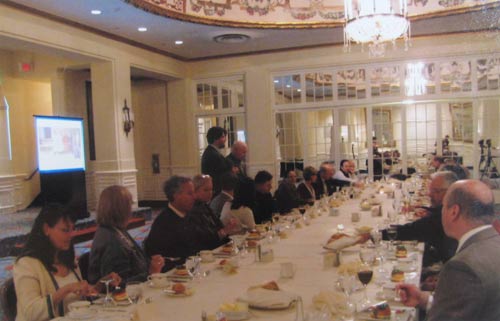 INSET PHOTO C WITH TAG: Collector’s luncheon and slide show presentation INSET PHOTO C WITH TAG: Collector’s luncheon and slide show presentation
I was fascinated and nearly overwhelmed by my feelings after hearing Mikhail speak. Previously accustomed to learning about art through recorded phones provided as museum tours, I embraced the rare opportunity to enjoy such a specific narration and history of the paintings by the artist himself. I wrote notes on my napkin to not forget details. Adding to my excitement was the fact that my own personal art collection, as well as some of my clients’ art collections, contained masterpieces by the Kugach artists. To see images of magnificent multi-figural compositions rarely seen outside Russia, wherein each figure and detail represents the artists’ vision is alone a treat, but to hear the artist author the visual story with his own words and tell the stories behind his father’s famous works was magical. For example, Mikhail stated that, “The artist must have empathy for each character in the painting in order to paint their truth;” “A composition is an idea that takes on flesh;” “Here is a finished work of art—in it, you can see what happened before the moment and what will happen after;” and, “Artists have a responsibility to show [the public] how to see beauty.”
I must admit, hearing the artist’s passion and conviction regarding the importance of art moved me profoundly, as I felt awed by the greatness of the artists. With each painting presented during the slideshow, hearing the stories and depictions from Mikhail, I could not help but well up with tears, discovering the secrets and seeing the triumph of the paintings, one story after the other unfolding before us. Jonathan Wurdeman, as translator, definitely captured the romance and heartfelt stories, concluding with the thought that, “Only art—paintings—can make the dumb speak and the deaf begin to hear!”
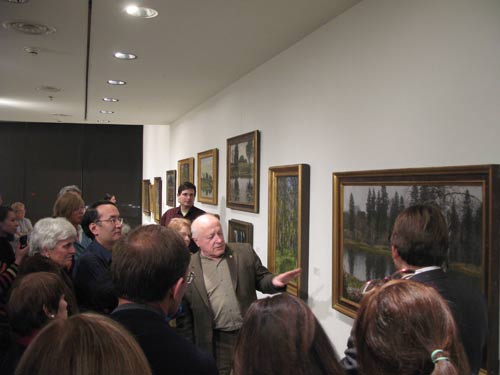  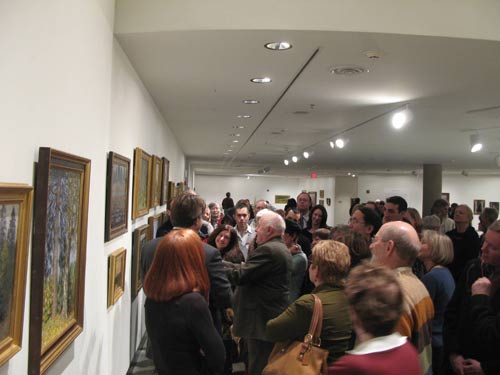
Opening night of Kugach-Kugach-Kugach at the Katzen Art Center.
Finally, the moment of the museum show was here at last, taking place in the beautiful and modern circular space of the Katzen Art Center at American University. Mikhail and his wife, along with their son, Ivan, provided meet-and-greets with visitors. Mikhail, with the translating of Jonathan Wurdeman once again, provided a walking tour of the museum in the round, revisiting and discussing each painting with anecdotes and comments. The paintings displayed were on loan from collectors, and the personal stories shared by Mikhail gave the collectors a wonderful opportunity to learn background information and new things about their paintings. For example, Mikhail spoke of his painting entitled “Snow Quietness,” explaining how he approached the owner of the work-horse in the painting, who was still being fed well in the winter, saying to the owner that, “The horse works spring through fall for his food, so why not have him work in the winter for his keep by letting us paint him?” Mikhail told the owner of the painting, a Holmdel, New Jersey resident loaning the painting to the museum for the Kugal exhibit, that there is a time during a good Russian winter storm when the wind stops, and the snow drops from the sky as big as half the length of your finger; the painting was done from life outside in the snow, thus becoming a very limited palette painting, where denser snow falling is rendered darker in the background and lighter in the foreground. The similar colors of the subject, mostly white, make the artist’s painting a very sensitive study to create. Only through very exact and subtle nuances of warm and cool values of the same color placed perfectly next to one another can the artist create depth and allow our eyes to see further detail and realism, despite the abstract shapes of the paint upon inspecting the painting up close. This particular painting was also proudly framed by my James Yarosh Associates Fine Art Gallery in a white-gold leaf, Stanford White-inspired frame, with skgrafito panel detail.
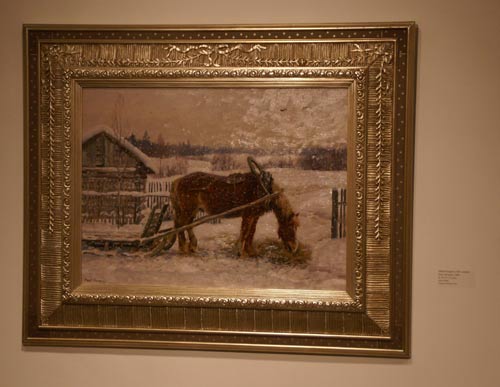
Mihail Kugach (1939 -) ‘Snow Quietness’ 2000- oil on board
Another example of Mikhail sharing the details behind the Kugach masterpieces is when he spoke of his father’s painting, “17th Century- First Snow.” The painting was of a subject that both interested and amused Yuri, his father. The symbol of the powder-faced royalty represents the great nobility of mother Russia. The costumes of the era are observed, such as the extended sleeves covering the hands for warmth when relaxed and the pale complexion and exaggerated rosy cheeks of the central figure in the road as she passes through the street. On both sides of the woman are other characters, including a young man depicting the religious zealots, portrayed almost as a jester on the street. He has, with intense curiosity and without regard or sense for appropriate attire, run onto the street without even shoes, to see what spectacle is passing. Mikhail told how his father has always been amused by these people who are considered to be extreme; town idiots who are, perhaps, not as dumb as they appear because they have happily avoided all social norms and exercise freedom to behave and speak without self-censor or political ramifications. The figure on the left of the painting finds himself staring at the jester-type character’s reaction to the procession rather than the procession itself. The artist calls attention to the other figure on the opposite side of the street, who represents another deeply religious man, very serious with his staff and head facing straightforward, focused and undistracted by either the jester-type character or the procession.
Mihail Kugach discusses ‘17th Century- First Snow ‘ with translation by Jonathan Wurdeman
As the evening drew to a close, Mikhail discussed his father’s most recent painting, “Moonscape,” incredibly painted by Yuri in 2007, then 90-years-old. It is a moonscape above the water. Mikhail shared that his father, considered to be one of the most important artists in Russia, had completed a series of paintings that just blew away his peers and followers, who perhaps thought Yuri’s advanced age had caused him to lose his artistic luster. The moonscape paintings, like the epic story paintings of the artist’s past, now offer the night impression of the artist, painting in the darkness of night. Profoundly, we are asked to imagine the artist with his palette, black with night, as is his canvas, working alone, at the end of his life, staring at the heavens and working by the dim moonlight’s reflection, poised next to the rippling, endless sea with just a small fire still burning in the distance, otherwise enveloped in the night’s darkness and the heavens above. In this way, the work offers not only a subtle, luminous moonscape, but also a metaphor serving as the artist’s self-portrait facing mortality.
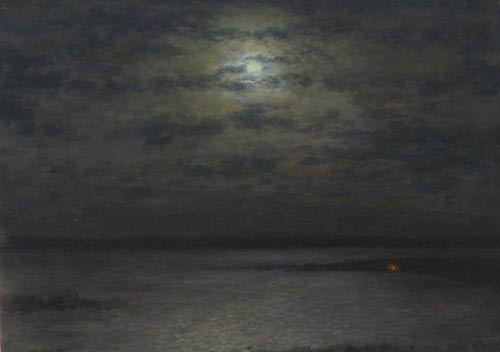
Yuri Kugach (1917-) ‘Moonscape’ 2007- oil on board )
And so, I would like to thank the collectors and friends who made the trip to Washington, D.C. with me, as well as the art collectors willing to lend their painting collected through the gallery for the exhibit, “Kugach, Kugach, Kugach: Three Generations of Russian Artists.” In close, I left the show in a state of complete happiness, pride, and contentedness, with the only desire and wish that I could collect more paintings in the future, feeling grateful I can make appreciating the arts a priority in my life.
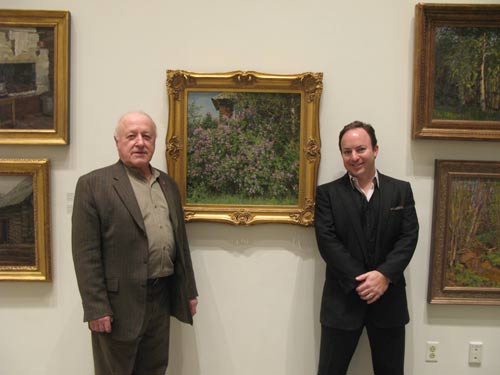 Mihail Kugach stands with James Yarosh in front in the painting he considers one of his father Yuri’s best landscapes, ‘ Lilacs in Bloom’ 1994- oil on board) Mihail Kugach stands with James Yarosh in front in the painting he considers one of his father Yuri’s best landscapes, ‘ Lilacs in Bloom’ 1994- oil on board) |